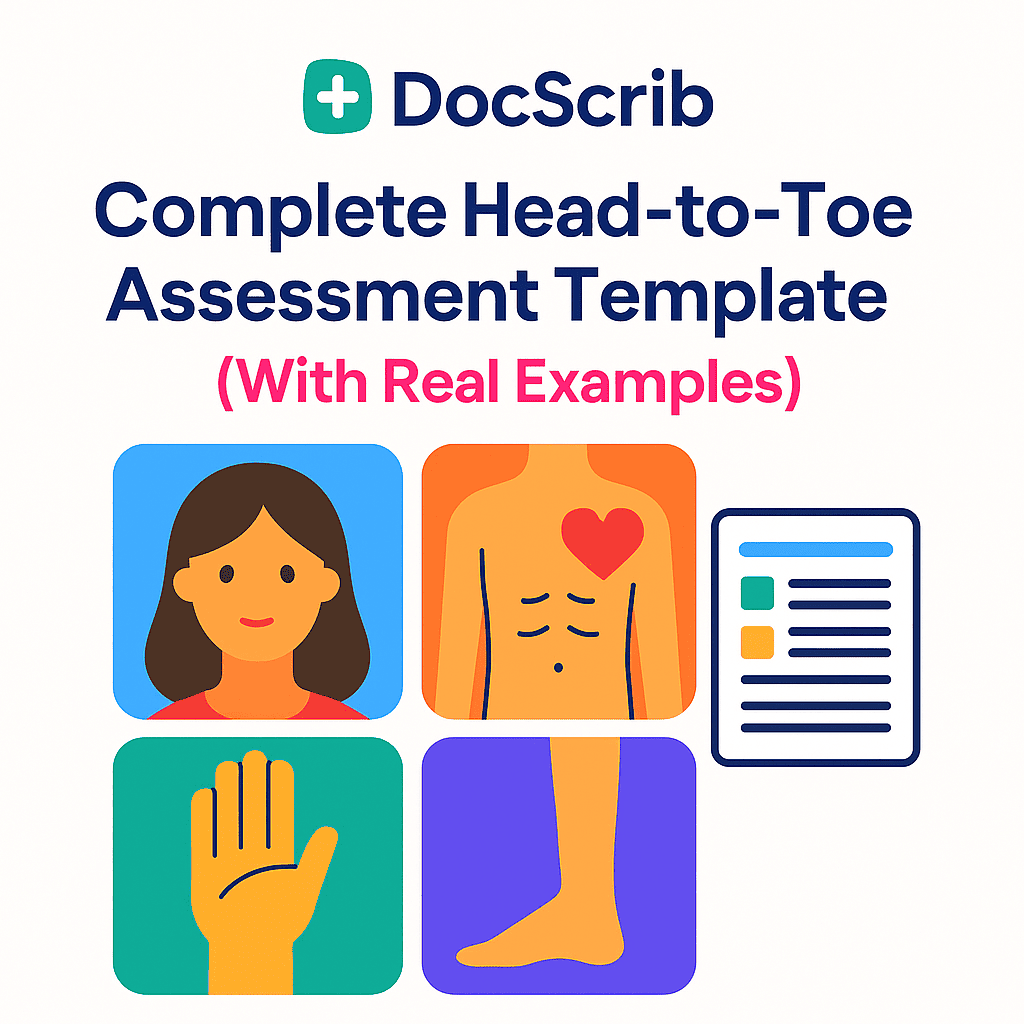Updated on: July 3, 2025
The Ultimate Guide to Head-to-Toe Physical Assessment (With Free Template)
In fast-paced clinical environments, accuracy and consistency are vital. One of the most fundamental skills for nurses, physicians, and allied health professionals is the head-to-toe assessment. This comprehensive evaluation not only ensures holistic patient care but also improves documentation accuracy—especially when paired with smart tools like DocScrib.
This article will cover:
- What a head-to-toe assessment is
- Why it matters across clinical settings
- A detailed step-by-step checklist
- Downloadable template
- How AI scribes enhance documentation
🧠 What is a Head-to-Toe Assessment?
A head-to-toe assessment is a systematic physical examination that evaluates all major body systems. It’s used to collect baseline data, monitor changes, and detect abnormalities. Whether in an ER, ICU, primary care office, or nursing home, this approach provides structure and clarity during patient encounters.
📌 Why is a Head-to-Toe Assessment Important?
| Benefit | Explanation |
|---|---|
| ✅ Standardized Approach | Reduces variability and errors across clinicians |
| 🧠 Cognitive Aid | Helps focus attention during high-stress or complex evaluations |
| 📋 Legal Protection | Thorough documentation protects against liability |
| 🔁 Clinical Communication | Ensures all care team members are aligned |
| ⏱️ Time Management | Speeds up workflow when paired with scribing or templates |
🧰 Preparation Before the Exam
Before starting, ensure the following:
- Hand hygiene and use of gloves where appropriate
- Consent from the patient
- Ensure privacy and a calm environment
- Supplies: stethoscope, penlight, watch, BP cuff, thermometer, pulse oximeter, and gloves
- Review patient’s medical history, allergies, and concerns
✅ Step-by-Step Head-to-Toe Assessment
Below is a full breakdown of the sequence used by clinicians and nursing staff:
1. General Survey
- Assess level of consciousness (LOC), orientation, posture, facial expression, hygiene, mood
- Record vital signs: BP, pulse, respiration rate, temperature, SpO₂, pain score
2. Head, Hair & Scalp
- Check for:
- Scalp lesions, dryness, parasites
- Head symmetry, shape, size
- Hair texture, distribution, and hygiene
3. Eyes
- Inspect:
- Conjunctiva (pallor or injection)
- Pupils (PERRLA: pupils equal, round, reactive to light and accommodation)
- Sclera color (jaundice or hemorrhage)
- Visual tracking and cardinal fields of gaze
4. Ears
- Inspect external ears for alignment, discharge, and lesions
- Palpate for tenderness
- Whisper test or audiometry (if applicable)
5. Nose & Sinuses
- Inspect nasal mucosa, septum alignment
- Palpate frontal and maxillary sinuses
- Check for nasal obstruction or discharge
6. Mouth & Throat
- Observe:
- Lips: color, hydration, lesions
- Teeth: hygiene, caries
- Mucosa: ulcers, thrush
- Tongue: movement, coating
- Uvula and tonsils
- Gag reflex and speech articulation
7. Neck
- Palpate:
- Trachea for deviation
- Lymph nodes (pre/postauricular, submandibular, cervical, supraclavicular)
- Thyroid gland (size and nodules)
- Check ROM and carotid pulses
8. Chest & Respiratory
- Inspect symmetry, shape, and effort of breathing
- Auscultate:
- Lung fields (anterior, lateral, posterior)
- Adventitious sounds (crackles, wheezes, stridor)
- Percuss for resonance or dullness
9. Cardiovascular
- Inspect for visible pulsations or cyanosis
- Palpate apical impulse, peripheral pulses (radial, dorsalis pedis)
- Auscultate heart sounds (S1, S2, murmurs)
10. Abdomen
- Sequence: Inspect → Auscultate → Percuss → Palpate
- Note:
- Contour (flat, rounded, distended)
- Bowel sounds
- Tenderness, masses, rigidity
11. Genitourinary (if indicated)
- Assess:
- Urinary patterns, retention, pain
- External genitalia (as needed, especially in urology or OB/GYN)
- Always ensure privacy, chaperone policy, and consent
12. Musculoskeletal
- Inspect joints, muscle bulk, and gait
- Assess:
- Range of motion (active/passive)
- Strength (graded 0–5)
- Deformities, edema, contractures
13. Neurological
- Level of consciousness: Alert, Lethargic, etc.
- Cranial nerves II–XII (as appropriate)
- Motor and sensory function
- Reflexes (e.g., Babinski, DTRs)
- Balance, coordination (Romberg, finger-to-nose)
14. Integumentary System
- Inspect:
- Skin tone, integrity, pressure ulcers, rashes
- Temperature, turgor, capillary refill (<2 sec)
- Scars, tattoos, IV sites
15. Psychosocial / Mental Status
- Affect, mood, speech, behavior
- Orientation to time, place, person
- Screen for suicidal ideation, substance abuse, cognitive decline if relevant
📄 Free Head-to-Toe Assessment Template (PDF/Doc)
👉 Download the Template DocScrib_Head_to_Toe_Assessment_Clean
Includes:
- Pre-filled checklist
- Notes section per body system
- Editable for EHR integration or mobile documentation
🤖 How DocScrib Enhances Head-to-Toe Assessments
With DocScrib’s AI Medical Scribe, clinicians can:
- Dictate findings while examining the patient
- Automatically populate SOAP or custom templates
- Reduce admin work by over 70%
- Maintain accuracy with real-time transcription and medical terminology
💡 “DocScrib lets me stay present with patients while documenting effortlessly.” – Internal Medicine Physician, California
🏁 Final Thoughts
Head-to-toe assessments remain a clinical staple, but they don’t have to be time-consuming or repetitive. By combining a standardized template with AI-powered scribing from DocScrib, healthcare professionals can ensure consistency, improve patient safety, and reclaim valuable time.
📥 Ready to transform your clinical documentation?
Get started with DocScrib today →
